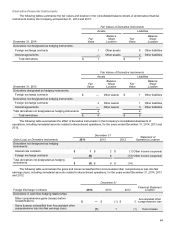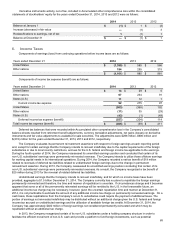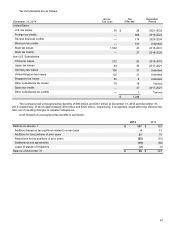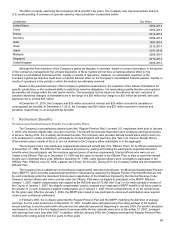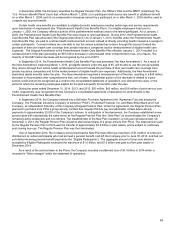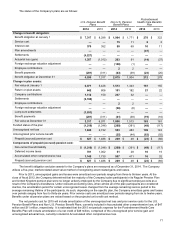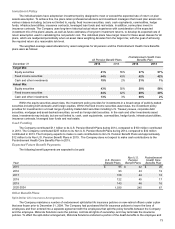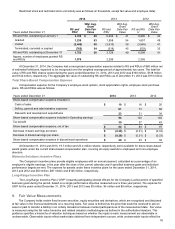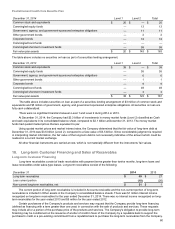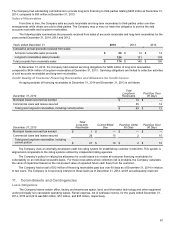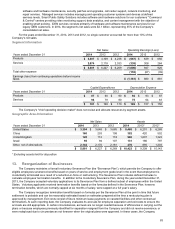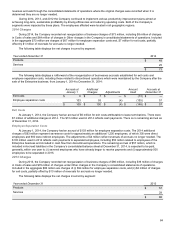Motorola 2014 Annual Report Download - page 76
Download and view the complete annual report
Please find page 76 of the 2014 Motorola annual report below. You can navigate through the pages in the report by either clicking on the pages listed below, or by using the keyword search tool below to find specific information within the annual report.
74
upon the death of the employee, the employee’s beneficiary typically receives the designated portion of the death benefits
directly from the insurance company and the Company receives the remainder of the death benefits. It is currently expected that
minimal cash payments will be required to fund these policies.
The net periodic pension cost for these split-dollar life insurance arrangements was $5 million for the years ended
December 31, 2014, 2013 and 2012. The Company has recorded a liability representing the actuarial present value of the future
death benefits as of the employees’ expected retirement date of $66 million and $51 million as of December 31, 2014 and
December 31, 2013, respectively.
Deferred Compensation Plan
The Company amended and reinstated its deferred compensation plan (“the Plan”) effective June 1, 2013 to reopen the
Plan to certain participants. Under the Plan, participants may elect to defer base salary and cash incentive compensation in
excess of 401(k) plan limitations. Participants under the Plan may choose to invest their deferred amounts in the same
investment alternatives available under the Company's 401(k) plan. The Plan also allows for Company matching contributions
for the following: (i) the first 4% of compensation deferred under the Plan, subject to a maximum of $50,000 for board officers, (ii)
lost matching amounts that would have been made under the 401(k) plan if participants had not participated in the Plan, and (iii)
discretionary amounts as approved by the Compensation and Leadership Committee of the Board of Directors.
Defined Contribution Plan
The Company and certain subsidiaries have various defined contribution plans, in which all eligible employees may
participate. In the U.S., the 401(k) plan is a contributory plan. Matching contributions are based upon the amount of the
employees’ contributions. The Company’s expenses for material defined contribution plans for the years ended December 31,
2014, 2013 and 2012 were $31 million, $32 million and $30 million, respectively.
Beginning January 1, 2012, the Company may make an additional discretionary 401(k) plan matching contribution to
eligible employees. For the years ended December 31, 2014, 2013, and 2012 the Company made no discretionary matching
contributions.
8. Share-Based Compensation Plans and Other Incentive Plans
Stock Options, Stock Appreciation Rights and Employee Stock Purchase Plan
The Company grants options to acquire shares of common stock to certain employees and to existing option holders of
acquired companies in connection with the merging of option plans following an acquisition. Each option granted and stock
appreciation right has an exercise price of no less than 100% of the fair market value of the common stock on the date of the
grant. The awards have a contractual life of five to fifteen years and vest over two to four years. Stock options and stock
appreciation rights assumed or replaced with comparable stock options or stock appreciation rights in conjunction with a change
in control of the Company only become exercisable if the holder is also involuntarily terminated (for a reason other than cause)
or quits for good reason within 24 months of a change in control.
The employee stock purchase plan allows eligible participants to purchase shares of the Company’s common stock
through payroll deductions of up to 20% of eligible compensation on an after-tax basis. Plan participants cannot purchase more
than $25,000 of stock in any calendar year. The price an employee pays per share is 85% of the lower of the fair market value of
the Company’s stock on the close of the first trading day or last trading day of the purchase period. The plan has two purchase
periods, the first from October 1 through March 31 and the second from April 1 through September 30. For the years ended
December 31, 2014, 2013 and 2012, employees purchased 1.4 million, 1.5 million and 1.4 million shares, respectively, at
purchase prices of $51.76 and $53.79, $43.02 and $50.47, and $34.52 and $42.96, respectively.
The Company calculates the value of each employee stock option, estimated on the date of grant, using the Black-Scholes
option pricing model. The weighted-average estimated fair value of employee stock options granted during 2014, 2013 and 2012
was $11.02, $9.52 and $9.60, respectively, using the following weighted-average assumptions:
2014 2013 2012
Expected volatility 21.7% 22.1% 24.0%
Risk-free interest rate 1.6% 0.9% 0.8%
Dividend yield 2.5% 2.4% 2.2%
Expected life (years) 5.2 5.9 6.1
The Company uses the implied volatility for traded options on the Company’s stock as the expected volatility assumption
required in the Black-Scholes model. The selection of the implied volatility approach was based upon the availability of actively
traded options on the Company’s stock and the Company’s assessment that implied volatility is more representative of future
stock price trends than historical volatility.
The risk-free interest rate assumption is based upon the average daily closing rates during the year for U.S. Treasury
notes that have a life which approximates the expected life of the option. The dividend yield assumption is based on the
Company’s future expectation of dividend payouts. The expected life of employee stock options represents the average of the
contractual term of the options and the weighted-average vesting period for all option tranches.


